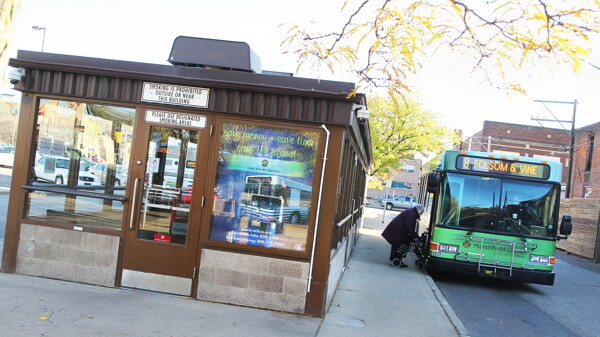Waiting for a Transfer
at long last, Eau Claire could get a new bus center
Tom Giffey, photos by Andrea Paulseth |

After years of waiting for federal dollars that never came, Eau Claire officials have finally decided that they’ll have to make the first move to replace the city’s outdated bus transfer center. The City Council voted recently to prioritize $125,000 in its 2015 budget to draw up plans and find a site for a new structure.
The current Spartan concrete-block-and-glass building that sits at the center of Eau Claire public transportation system was built to be temporary way back in 1984. Mass transit advocates have long sought funding to build a transfer center more befitting a bustling, mid-sized city, or at least one that had basic amenities such as heat and bathrooms. (Heat and air-conditioning were added recently, but the bus riders will have to continue to resist nature’s call.) For years, city officials hoped that they could build a new transfer center with a congressional earmark, says City Councilman Andrew Werthmann. However, the hoped-for federal money never materialized, and likely never will considering that federal budget earmarks are now less popular in Congress than Congress is in the rest of the country.
“Historically this project has been moved, and moved, and moved for years.” – Mike Branco, Eau Claire Transit manager, on building a new bus transfer center“There’s always this talk that four million’s going to get secured and will make it’s way to Eau Claire for the transfer center, but it’s not going to happen,” says Werthmann, who also serves on the city Transit Commission. The recent 11-0 vote doesn’t actually set aside the money; that won’t happen until a year from now when the council passes its 2015 budget. However, the unanimous action makes it clear that building a transfer center is a City Council priority, Werthmann says.
Such prioritization has been a long time coming. “Historically this project has been moved, and moved, and moved for years,” says Eau Claire Transit Manager Mike Branco. The prospect of a new transfer center has suffered as federal funding has dried up. In the past, the feds would set aside $15 million to $20 million annually for mass-transit infrastructure in Wisconsin, Branco says. Eau Claire was always high on the list of potential recipients, but never quite reached the top. Now, the feds allocate only about $1.5 million annually for Wisconsin. “When we’re primed and pumped in being able to take that next step, the federal funding’s not there,” he laments.
Yet the need for a new building has only increased. Eau Claire bus ridership continues to grow, and at peak times as many as 14 buses are crowded into the concrete loop that surrounds the squat structure. And while the transfer center may now be heated, it still has the ambience of a garage.
The $125,000 penciled in by the council would pay for a survey of possible locations, a traffic study, and design and architectural work for a new structure. That structure would have to accommodate today’s larger buses, some of which stick out into traffic at the current center, Branco says. In addition to the fabled public restrooms, it would also offer ways to connect to taxis and other bus services, such as Greyhound and Jefferson Lines.
Because the project is at such an early stage, it’s hard to even estimate a price tag, although the city’s capital improvement plan recommends $4.625 million between 2015 and 2017. A location is also uncertain: Branco said he’d like to see it stay in the same block as it is now (South Farwell Street between Gray and Main streets), while Werthmann mentioned the possibility of building it in the city parking lot next to the Schlegelmilch-McDaniel House on Farwell Street or perhaps as part of the parking structure the city hopes to build on North Barstow Street where the Post Office now stands.
Branco and Werthmann agree that the city will have to be creative in paying for the center. They both point to a bus center recently built in La Crosse with a combination of federal, city, House and Urban Development, and private funds.
“Do I think we need a Taj Mahal?” Branco says. “No, but I do think we need a better structure and more room.”


















